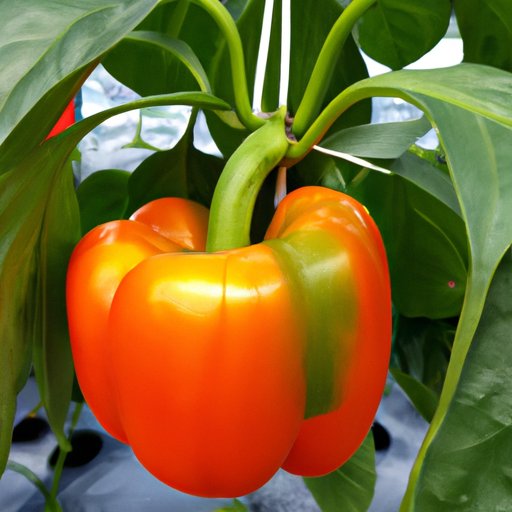Introduction
Are your bell pepper plants growing out of control? Are you struggling to manage their size and maximize their yield? Growing bell pepper plants can be challenging, but it doesn’t have to be. In this comprehensive guide, we’ll explore everything you need to know about understanding and managing the growth of bell pepper plants.
From Seed to Giant: Understanding the Growth of Bell Pepper Plants
Before we dive into how to manage the size of bell pepper plants, let’s first explore the life cycle of these plants and the different stages of growth and development. Bell pepper plants typically go through four phases in their life cycle: germination, vegetative, flowering, and fruiting.
During the first stage, germination, the seeds begin to sprout and develop roots and shoots. Once they have emerged from the soil, the plants enter the vegetative phase where they focus on growing leaves and establishing a strong stem. The flowering stage is when the plants start to produce flowers, and finally, during the fruiting stage, the plants produce their delicious bell peppers.
Several factors can affect the growth of bell pepper plants, including temperature, light, moisture, and nutrition. The better you understand these factors, the better equipped you’ll be to manage the size and yield of your plants.
The Ultimate Guide to Bell Pepper Plant Size: How to Grow Bigger, Heavier Vegetables
Planting and growing bell pepper plants require some best practices to achieve a bumper harvest of heavy, big-sized vegetables.
Selecting the Right Location: Choose a sunny location and have a good source of moisture with loamy soils. The ideal pH should be 6.0-6.5, which is slightly acidic.
Preparing the Soil: Before planting, prepare the soil by mixing in organic materials to provide necessary nutritions and to improve soil structure and drainage.
Planting the Seedlings: Prepare the holes and space them approximately two feet apart. Place the seedling into the soil about one to two inches deeper than they were in their pot. Cover with soil, press firmly, and water gently.
Fertilizing the Plants: Apply a balanced fertilizer once a month or as instructed by the manufacturer during the growing period. Also, supplement the soil with compost as fertilizer for a healthier plant.
To ensure that your bell pepper plant reaches its full potential, gather as much information as possible regarding its care. Regular weeding, pest control and applying appropriate supplemental nutrients, and proper irrigation will aid in a healthy plant growth.
Size Matters: Understanding the Factors That Affect Bell Pepper Plant Growth
Many factors contribute to the growth of bell pepper plants.
Environmental Factors: The growth of pepper plants is highly dependent on environment conditions, like the moisture content, temperature, light, and wind. Changing these non-nutritional factors will affect the growth and the plant’s size and the yield.
Soil Quality: Bell peppers require well-drained soil that is rich in organic material. Soil testing is recommended to determine the acidity of the soil, which preferably should be 6.0 and 6.5 ranges for better nutrient uptake for the plant’s improved growth
Use of Fertilizers: Bell pepper plants need a nutrient-rich fertilization program to maximize their growth and production. Adding compost or using organic fertilizers would make a healthy plant and enhance fruit growth and yield.
From Sprout to Harvest: What You Need to Know About Bell Pepper Plant Height and Yield
Bell peppers will continue to grow from seedling to maturity or harvesting stage. Monitoring the plant’s growth is critical to determine when to harvest peppers.
Determining When to Harvest: The bell pepper should be plucked out when they reach their desired size, color, and flavor. Once peppers attain a mature size (3-4 inches length), they can be plucked out. Bell peppers can be harvested multiple times from July to October.
Maximizing Yield: Bell peppers can be harvested repeatedly, therefore, it’s necessary to practice optimal nutrients and hygiene conditions. For optimal yield, ensure soil is moist and regularly supplement with fertilizers. The use of pesticides and appropriate pest control is also necessary at various stages of growth.
Managing the Height of Bell Pepper Plants: Bell pepper plants can grow quite tall, often reaching up to four feet in height. There are several techniques to control the plant’s height, including pruning, providing adequate support, and using dwarf varieties of bell pepper plants that naturally grow shorter.
Size Isn’t Everything: Tips and Tricks for Growing Compact, Yet Fruitful Bell Pepper Plants
Some gardeners prefer growing compact bell pepper plants. Compact plants have many advantages, including being less unwieldy, easier to manage, and requiring fewer structural supports. Below are tips for those hoping to grow compact bell pepper plants.
Planting in Containers or Raised Beds: Bell pepper plants can be grown in containers or raised beds, and with dwarf pepper varieties which are smaller in size, you would achieve healthy growing plants in a limited space.
Pruning: Regular pruning will help limit the plant’s vertical growth and stimulate the growth of flowers and fruits. Pinch off the growth tip of the plants’ central stem to help encourage bushiness form at the lower leaves and stimulate fruit production.
Proper Space: To limit the plant’s growth, ensure sufficient spacing between plants during planting, limiting nutrient availability, and reducing plant growth.
Conclusion
Successfully growing bell pepper plants takes some work, but with the proper understanding of its growth stages, nutrition, and other essential factors, it’s possible to manage the size and yield of your plants. By using the tips and techniques we’ve explored in this guide, you should be well on your way to growing fruitful, healthy bell pepper plants.
(Note: Is this article not meeting your expectations? Do you have knowledge or insights to share? Unlock new opportunities and expand your reach by joining our authors team. Click Registration to join us and share your expertise with our readers.)
